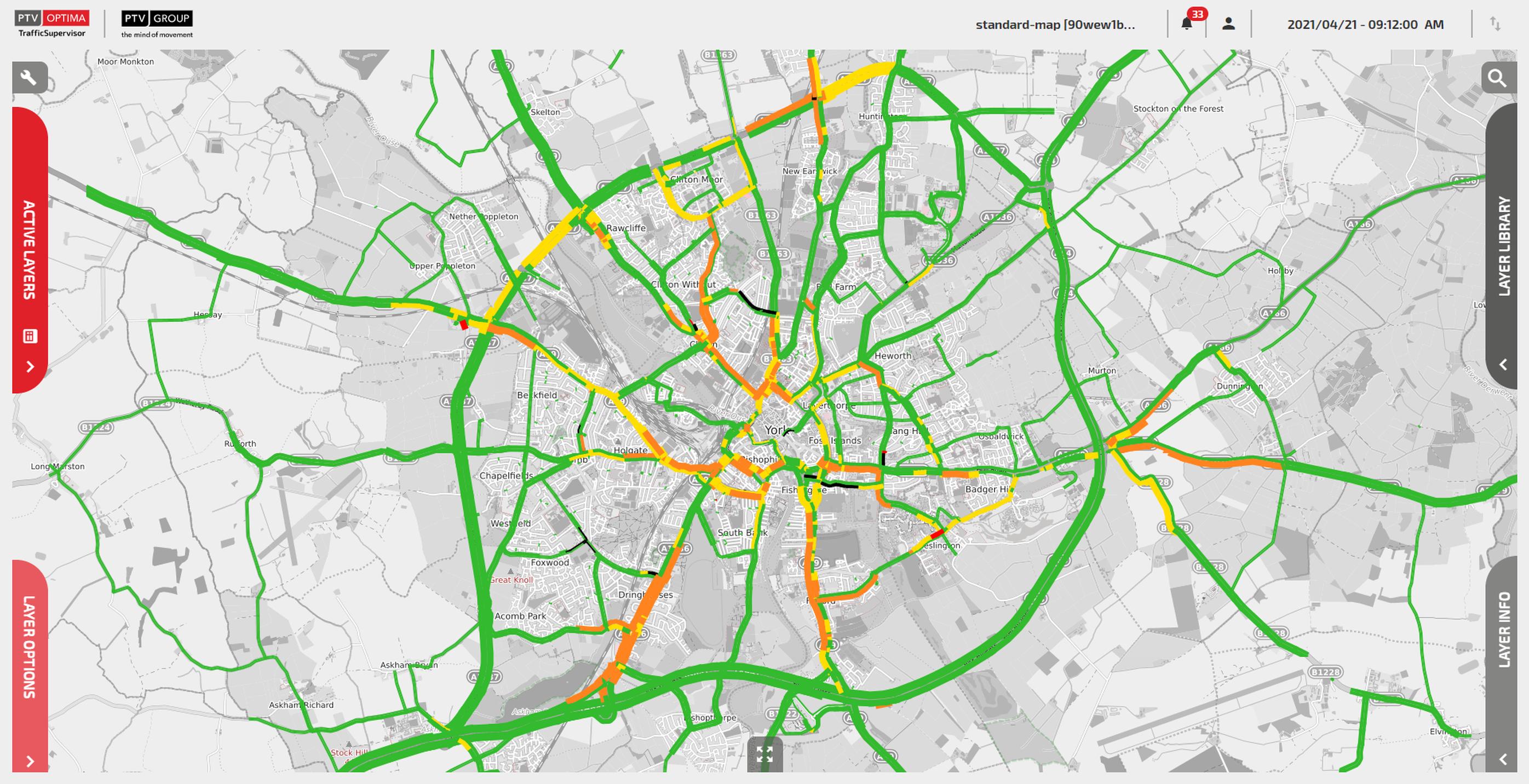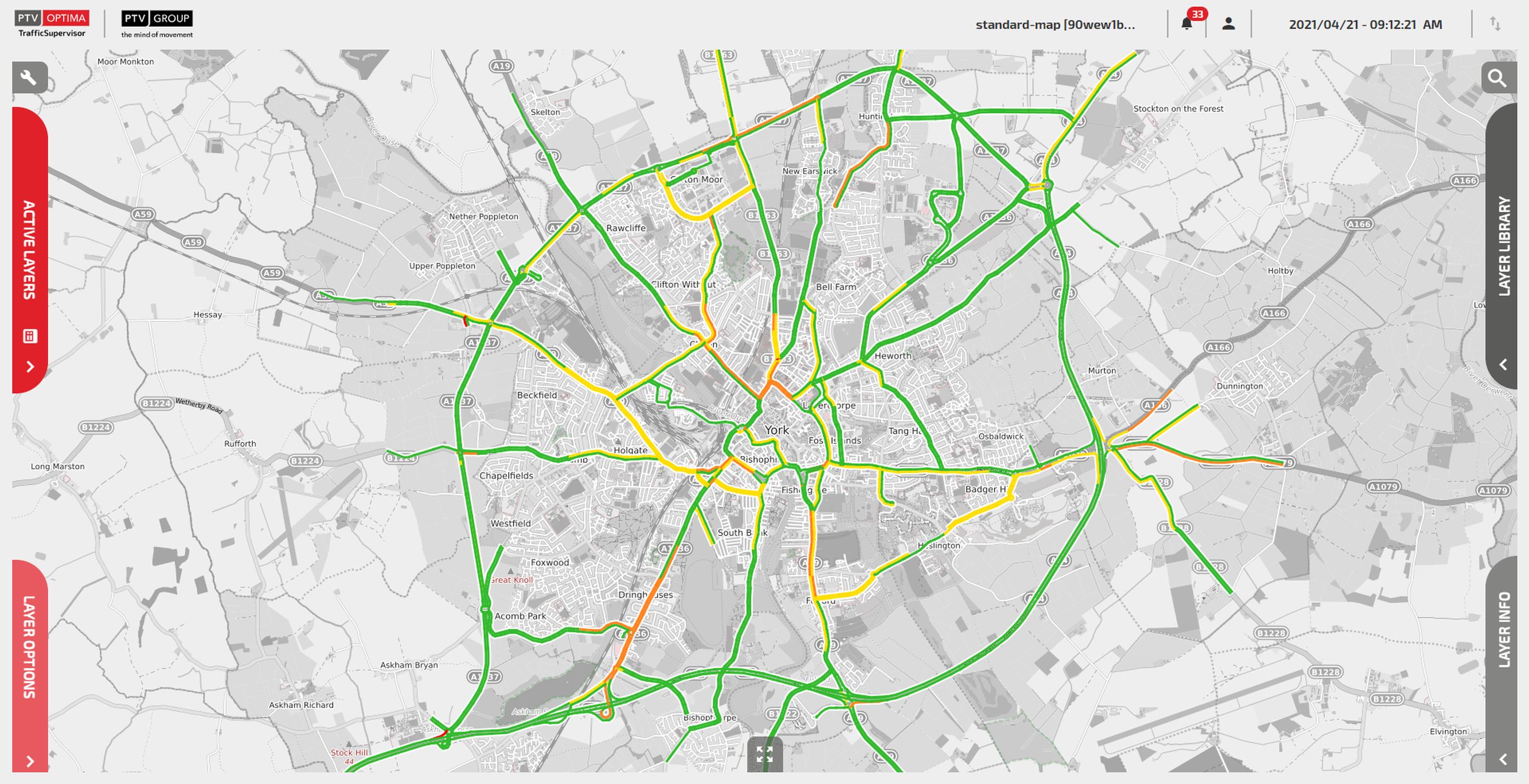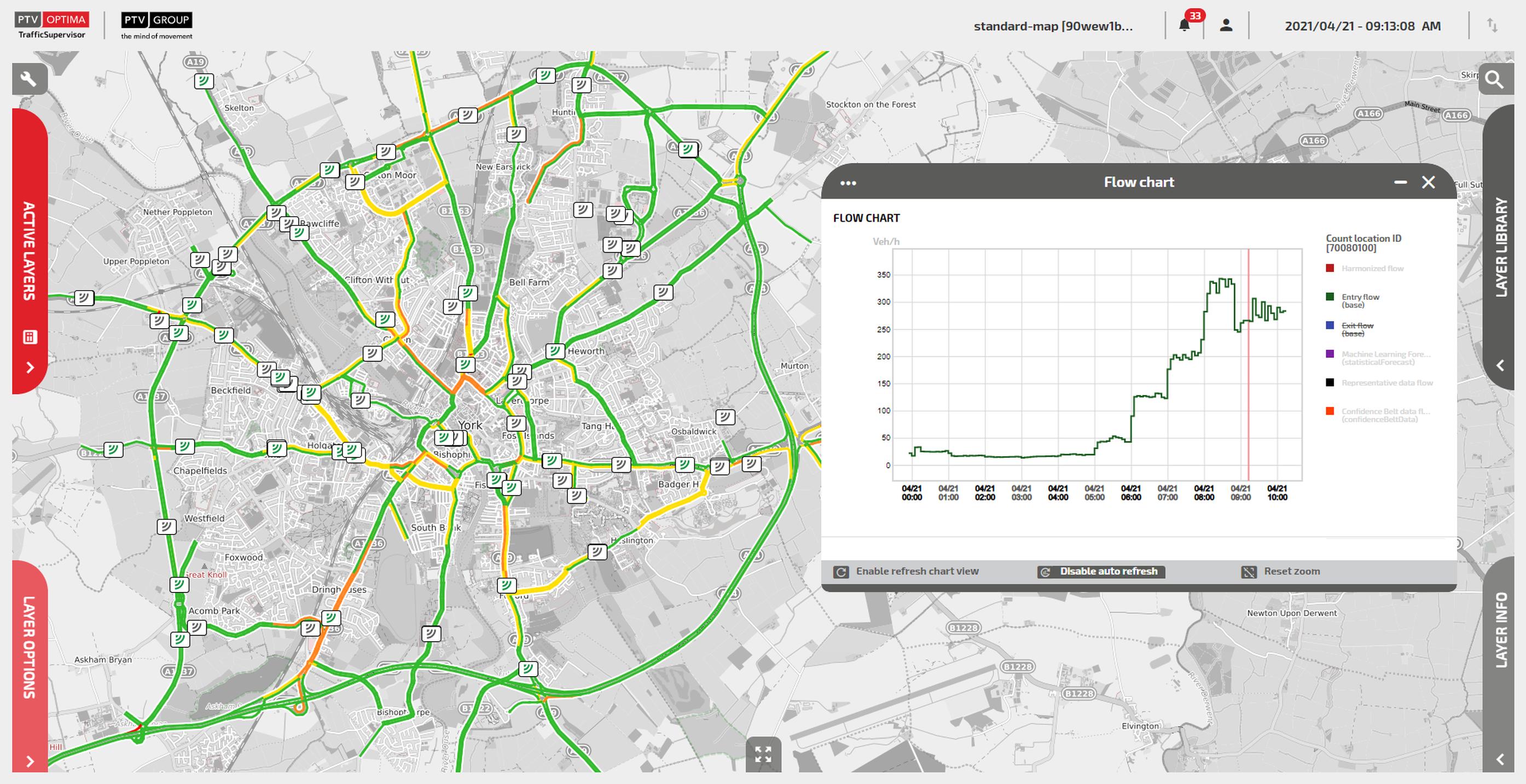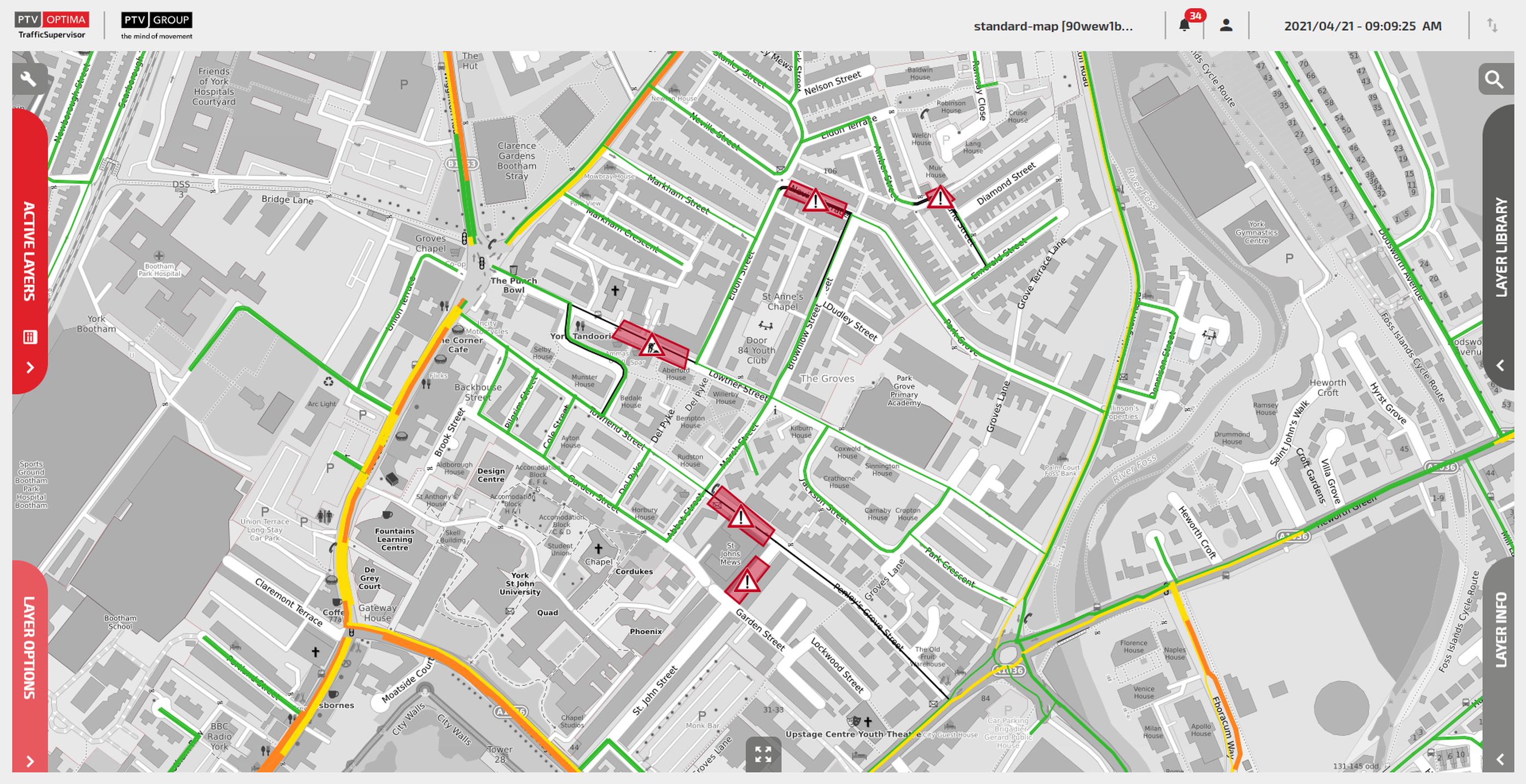






I first met James in December 2019. The occasion was to kick off a contract which had just been awarded for Wood Group to lead a consortium, including RelativeGAP and PTV, in the development of a new transport modelling asset for the City of York.
The project, and transport model, is part of the The National Productivity Investment Fund-funded, DfT-governed Smarter Travel Evolution Programme, or STEP. STEP aims to improve the connectivity and data collection of York’s transport technology assets to future-proof how the city deals with changing levels of demand.
The real-time transport model is a key component of STEP, and this has been implemented using PTV Optima.
Traffic signals are critical to the flow of traffic in York. They are also key tools for managing congestion and an important part of STEP, so I began with asking James how traffic signal plan management was done before, and how STEP will help. He explained:
“Before STEP, junctions would be modelled as best as possible; tested and adjusted by observation when implemented, followed by Network Monitoring Officers (NMOs) keeping an eye on CCTV, Twitter and social media for any incidents or congested traffic. This last bit was mostly reactive, and every second counts with network capacity.
“Optima, as part of STEP, now gives us prediction and alerts that can inform the NMOs well before crisis point, so interventions can be made earlier and more effectively, for example bringing the PM peak signal plans on sooner if an unexpected early peak is happening. A sort of prevention rather than a cure.”
One can think of Optima as a bit like a weather forecast for traffic. It combines a Visum traffic model with real-time data from a variety of sources to forecast traffic conditions for the current moment and up to one-hour ahead. By providing this forecast across the city it provides broader awareness of the current situation, and not just where the city has its own sensors, or from social media and CCTV.
When discussing real-time modelling with other cities and local authorities, coverage and quality of live flow and signal data often comes up as a blocker to them having their own real-time model.
I asked James how York came to have the necessary infrastructure. He explained:
“We had reasonable coverage of Automatic Traffic Counters (ATCs) that reported weekly, but to be honest, before STEP we had nearly no live flow feeds.
As part of STEP, we set about changing this by upgrading existing ATCs to near real-time and using existing traffic signal detectors like FLIR Traficams to send data near real-time over APIs.
We didn’t have to actually install much extra kit, just improve connectivity and functionality on existing stuff. We didn’t upgrade everything, we looked at a map of the city and worked out the most important sites such as arterials or congestion hotspots”.
Simple things like knowing who to go to for data sets within the organisation, and knowing which data is missing and needs to be collected, will make a huge difference on delivery timelines
The real-time model is now live and will be actively maintained for at least the next six years. It took around a year for the project team to implement the new strategic and real-time model; all whilst overcoming many interesting challenges, not least the global pandemic. I asked James what his advice would be to other local authorities in preparing for such a project.
“Ring me, I’m happy to share all the triumphs and pitfalls! In seriousness, the best advice I can give to other local authorities is two-fold.
“Firstly, build a checklist of all the data required to power a strategic and real-time model, then gather as much of it as possible before appointing anyone.
“Simple things like knowing who to go to for data sets within the organisation, and knowing which data is missing and needs to be collected, will make a huge difference on delivery timelines.
“This is something we did before procuring, and it really paid off.
“The second thing is to appoint a competent systems integrator to the project, whether it’s internal or external, so that the nitty gritty of getting sensor data from different systems across local authority and third party digital networks into a real time model doesn’t become unwieldy.
“This can be hard stuff to do, but there are good people out there that can help to take a lot of the stress out of it – a shout out to Jon Wade who helped us with STEP proof of concepts.”
And finally, I asked, were there any limitations or areas where you would like to see STEP and the real-time model grow into, and which technology may enable in future?
“I would like to see the model integrated with real-time public transport feeds so we can see right away which buses we could prioritise and what the effect on the rest of the network would be if we did so.
“Combining this with how full the bus is would be really useful, so we could prioritise based on affected passengers.
“I would also like to see traffic signal plans set automatically based from real-time model outputs. We have been working together with PTV on this already, which is exciting.”
Optima, as part of STEP, now gives us prediction and alerts that can inform the NMOs well before crisis point, so interventions can be made earlier and more effectively such as bringing the PM peak signal plans on sooner if an unexpected early peak is happening. A sort of prevention rather than a cure?
The new Bus Open Data Service is nicely timed in this respect. As we have done in other cities, live bus location data can be imported into Optima so that monitoring officers can see where buses are in real-time, along with their current delays, and use this information to support decision making on where, when, and how to prioritise interventions.
This project has offered a fascinating opportunity for the team at PTV to see how transport modelling can provide a real benefit to the day-to-day running of a transport system, increasing capacity, literally in real-time, rather than for a scheme with a 60-year forecast horizon.
I am grateful to James and the team at York for being a progressive and friendly project partner, and we look forward to more successful projects in the future.
TransportXtra is part of Landor LINKS
© 2025 TransportXtra | Landor LINKS Ltd | All Rights Reserved
Subscriptions, Magazines & Online Access Enquires
[Frequently Asked Questions]
Email: subs.ltt@landor.co.uk | Tel: +44 (0) 20 7091 7959
Shop & Accounts Enquires
Email: accounts@landor.co.uk | Tel: +44 (0) 20 7091 7855
Advertising Sales & Recruitment Enquires
Email: daniel@landor.co.uk | Tel: +44 (0) 20 7091 7861
Events & Conference Enquires
Email: conferences@landor.co.uk | Tel: +44 (0) 20 7091 7865
Press Releases & Editorial Enquires
Email: info@transportxtra.com | Tel: +44 (0) 20 7091 7875
Privacy Policy | Terms and Conditions | Advertise
Web design london by Brainiac Media 2020